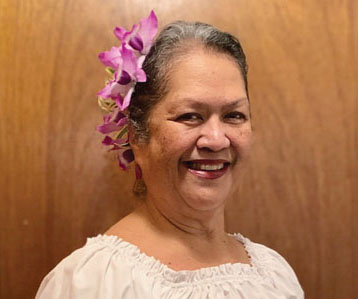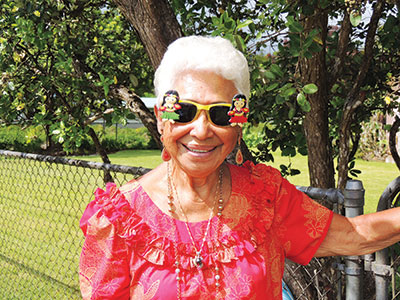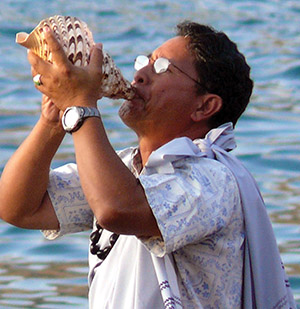
Sounding the Pū: An Echo of the Past Resonates Today
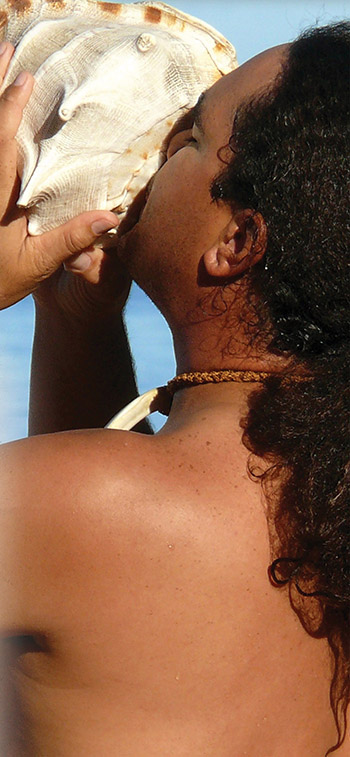
By Catherine Tarleton
The tropically iconic conch shell trumpet, or pū, is often seen at the lips of malo-clad beach boys, sounding the start of sunset and tiki torch lighting time. The tradition of the pū is ancient, sending out a sound that resonates attention, respect, and significance across the ocean and time.
In Hawai‘i for countless generations the pū has announced the arrival of canoes, the entrance of ali‘i, and the beginning of protocols. Today, its one-note fanfare is used to start a meeting, bless a home, or call a gathering to order.
“When I traveled on the Hōkūle‘a, we sailed to the Olympic Peninsula,” says Danny Kaniela Akaka, Cultural Specialist at Mauna Lani Bay Hotel and Bungalows.
“We got there later than expected, about two hours behind schedule. It was dark and cold and there was heavy fog. About 10 o’clock, I blew the pū through the fog. And as we got closer, the fog lifted and we saw all these families on the pier, singing.”
The pū is a horn heard around the world, in the Pacific Islands, and anywhere the great snail shells can be found. Triton shell trumpets were used in Italy as long ago as 5150 BC. “Blowing shells” are called Shanka in India, Dung-dkar in Tibet, Quiquizoani in Mayan culture, Nagak in Korea, and Horagai in Japan.
“Even in Yokohama in 2007 on the last leg of our journey, as we entered the harbor to tie up, we heard the pū,” says Danny. “The blower of the pū was a young Buddhist monk.”
Danny said the monk’s instrument was made of the Triton shell, not the Helmet shell used in Hawaiian pū, and that his had a metal mouthpiece attached. Used by Tibetan monks for thousands of years, the metal mouthpiece enables the pū blower to play different pitches.
“I spent time trying to learn from him,” says Danny. “He was the best that I have ever met.”
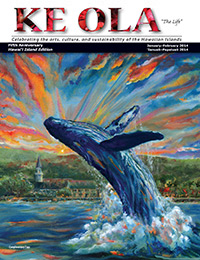
When he came to visit Danny in Hawai‘i, the young monk brought a pū that he had found while diving and fitted with a metal mouthpiece.
“My wife Anna put a cover of lauhala over it,” says Danny, “And if you ever heard it, it sounds like a Matson Ship coming in.”
The pū can be made from any large gastropod (sea snail) shell by removing or filing down the tip of the shell’s spire at its apex. Most in Hawai‘i are from the long pointed Triton’s Trumpet (Charonia tritonis) and the smaller smoother Helmet Shell (Cassis cornuta). The living snails feed on urchins, starfish, and other creatures, and due to their popularity, the shells have become exceptionally rare in Hawaiian waters.
Danny uses a Triton shell pū for house blessings and the Helmet shell pū for “Twilight at Kalāhuipua‘a” music and talk story at Eva Parker Woods Cottage. At one such gathering, he met Babe Bell, “the most famous pū-blower in Hawai‘i.”
“I don’t know about that, but I might be the oldest,” said Babe, 76, who has sounded the pū every day at the Ilikai Hotel on O‘ahu for more than 50 years. Afterwards, he performs the torch-lighting at the Duke Kahanamoku Statue, and on Fridays performs at Royal Hawaiian Shopping Center. An avid paddler with the Anuenue Canoe Club, Babe visits Kailua-Kona every year for the Queen Lili‘uokalani Long Distance Canoe Race, where he naturally blows the pū, too.
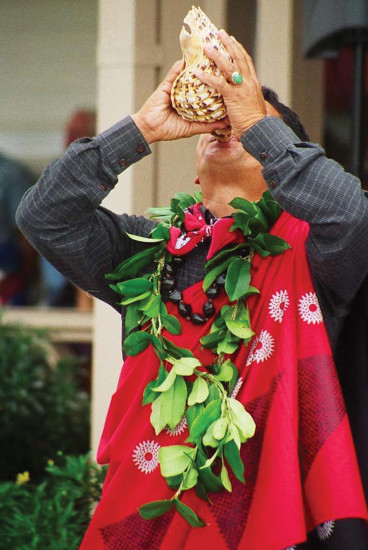
Akaka had admired Babe’s large Triton shell pū, and asked about its story at “Twilight.”
“I bought it at Disneyland for 35 dollars,” said Babe. “It was in a showcase over there, and I’ve been blowing that same one all these years. I guess it fits my mouth.”
Babe said that he accidentally ran over the shell with his Volkswagen Bug one time. “It made a puka, and I had to patch it with surfboard fiberglass.”
Babe learned to blow the pū from Kumu Hula Haunani Kahalewai at the Royal Hawaiian Hotel.
“I went to pick up my wife, and Haunani said, ‘You, you, and you—all you husbands and boyfriends come back tomorrow and we’re going to put you in the show.’ So I went and got a conch shell and taught myself to play. I played the trumpet in high school, so it was a similar vibration of the lips.”
Babe has blown the pū for parades, performances, blessings and funerals in Palau, American Samoa and the Solomon Islands, and next year plans a trip to Guam.
Like Babe, Danny has blown the pū in many different places, including Carnegie Hall in New York. He was scheduled to sing for the “Hawai‘i Calls” radio program, however, at the last minute someone handed him the pū.
“That pū belonged to John Papa I‘i. He was advisor to the ali‘i, and I’m sure that pū was heard by all the Kamehameha’s. That was a chicken skin moment,” Danny says.
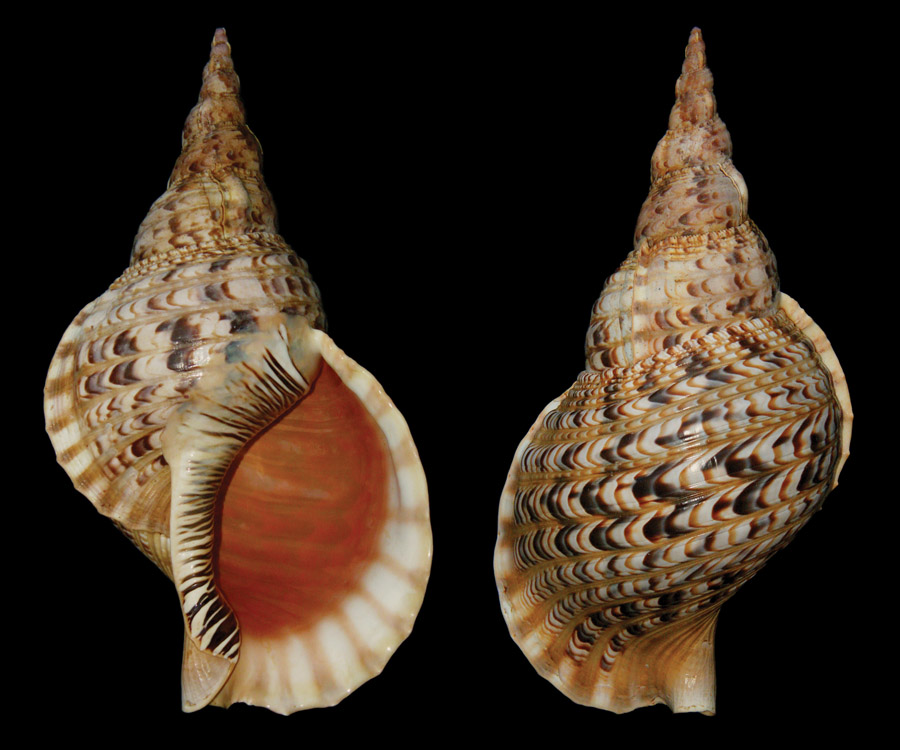
The pū caused chicken skin at the 2011 Big Island Film Festival at The Fairmont Orchid, Hawai‘i, as the welcome reception filled with glass clinking and excited chatter of filmmakers and fans. Two men stepped quietly forward, and the long low tone of the pū drifted over the crowd. A unique quiet settled—what Danny calls a “spiritual silence.”
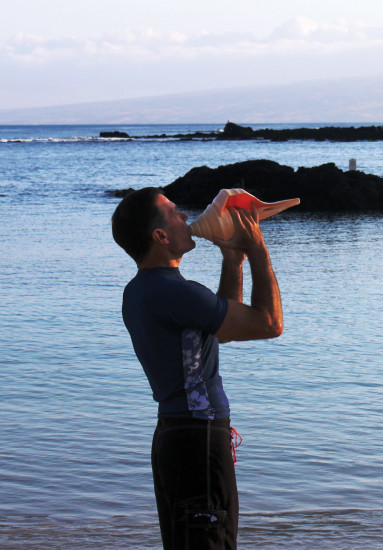
Danny was one of the pū-blowers that evening. The other was Chris Luedi, General Manager and Regional Vice President of The Fairmont Orchid, Hawai‘i. Together they heralded the four compass points and then blew heavenward, concluding with an oli chanted in unison.
Chris, originally from Switzerland, has embraced the Hawaiian culture in a way few physically can. Among other accomplishments, he has completed 10 of the renowned Moloka‘i Hoe canoe races and was part of a voyaging team that paddled more than 1,750 miles around the Hawaiian archipelago and chronicled in the film, “Family of the Wa‘a.”
Chris says, “When I came to Hawai‘i in 2002, seeing someone blowing the pū was very exotic, very foreign to me—quite mystical actually. I had no sense of what the meaning might be. I learned more when I got involved with canoes and paddling and with the culture as a whole. Kimokeo Kapahulehua, my mentor and paddling companion taught me how to blow the pū.”
To Chris the sound of the pū signifies the beginning of something—the beginning of a meeting, a blessing, the arrival of something new. As taught, he follows the protocol of blowing to the four compass points, then up and out to the audience.

“The sun rises in the east where a new day and a new hope has begun,” says Chris. “And the sun goes down in the west, hopefully after a good, productive day with great achievements. To the north, we salute the North Star—the big, bright star that guides us, and to the south, we acknowledge the people from the South Pacific, our forebearers who came to Hawai‘i. Then, upwards, we honor Ke Akua and the audience as well.”
Chris is often asked to talk about Hawai‘i, his experiences, and paddling adventures.
“I travel with my pū. When I am asked to do a little chant or blessing—as a hotel general manager and representative of the hotel—I take my pū and give oli and do whatever I am asked to do.”
“When you run a business in Hawai‘i, you have to honor the Hawaiian traditions and Hawaiian culture, particularly when you come from far away,” says Chris. “And that’s something I do try and bring to the forefront, that we allow our guests to partake of the culture and try to explain what it is. You can come to our hotel and really get a taste of what Hawai‘i is all about.”
Next time you’re at the beach or your favorite spot for sunset cocktails, when torch lighting begins and you hear the sound of the pū, allow yourself a moment of spiritual silence and reflection and appreciate being exactly where you are in place and time.
“Today, for torch lighting, it’s a sound of the past,” says Danny. “It’s an announcement that the day is coming to an end, and the pū kind of gives it a sense of the past.” ❖
Hawaiian ‘ōlelo

Danny Kaniela Akaka, Cultural Specialist at Mauna Lani Bay Hotel & Bungalows, tells a traditional Hawaiian ‘ōlelo (story) about a dog named Puapualenalena and a famous pū named Kihapu:
“Puapualenalena and his owner, an old man, were living in Waipi‘o Valley and the old man would send the dog out to bring him ‘awa from the king’s ‘awa patch. The king asked, “Who has the nerve to steal from my ‘awa patch?” He sent people to find out and they only saw the dog.
They followed Puapualenalena to the old man’s home and arrested the man and the dog, and took them to the king. The king said, “You broke the kapu, and you deserve to die!”
The old man asked, “If I can get your favorite pū back from the Menehunes, will you spare our lives?”
When the king said yes, the old man sent the dog up the valley to the Menehunes, who played with him and danced and danced and danced as they loved to do—all through the night until they dropped to sleep. Then, Puapualenalena grabbed Kihapu and ran back down the steep trail, but the wind made the pū sound and it woke up the Menehunes. They chased him, and at one point he dropped the pū and it chipped, but he was able to grab it again and run home.
The old man took the pū back to the king and as a reward, he was given a lifetime supply of ‘awa.
That pū, Kihapu is in the Bishop Museum, and you can see where it is chipped!”
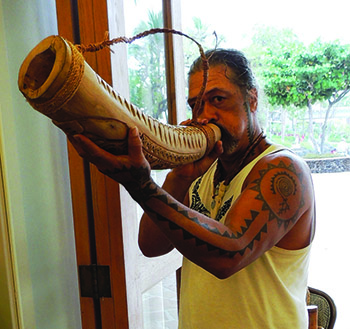
In the Marquesas Islands, pū can be very large and sometimes made of wood. At the recent Moku O Keawe International Festival at Hilton Waikoloa Village, carver Dean Ka‘ahanui demonstrated his Marquesan-style pū, which he learned about while visiting Tahiti. Long and powerful, each “pū lau” is painstakingly carved with tribal patterns and decorated with shell pieces, making each instrument a unique work of art. From Waimea, Ka‘ahanui often chooses native woods including koa, only from fallen trees.
“If there’s nobody but me around, I can carve all day,” he says. “I love it like I love the ocean.”
Contact photographer Michael F. O’Brien: onggi@hawaii.rr.com
Contact writer Catherine Tarleton: catherinetarleton@gmail.com

